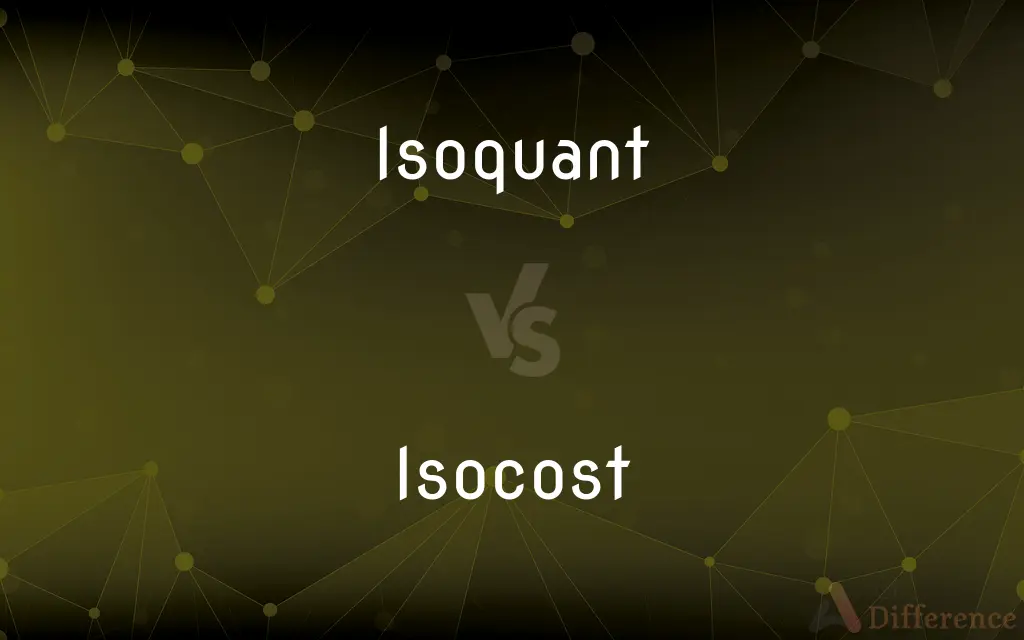Isoquant vs. Isocost — What's the Difference?
By Urooj Arif & Fiza Rafique — Updated on March 10, 2024
Isoquants represent different combinations of inputs producing the same output, highlighting production efficiency, while isocost lines show various input combinations available at a fixed cost, focusing on budget constraints.

Difference Between Isoquant and Isocost
Table of Contents
ADVERTISEMENT
Key Differences
Isoquants and isocost lines are fundamental concepts in economics, specifically in the analysis of production and cost. An isoquant curve depicts various combinations of two inputs, such as labor and capital, which result in the same level of output. This curve helps in understanding the substitution effect between inputs while maintaining the same level of production. On the other hand, an isocost line represents all the combinations of two inputs that can be purchased with a specific budget. The slope of an isocost line is determined by the ratio of the prices of the two inputs, reflecting the trade-off between them given the budget constraint.
While isoquants focus on the efficiency of production processes, isocost lines concentrate on the cost aspect of producing a certain level of output. Isoquants are convex to the origin because of the diminishing marginal rate of technical substitution, which means that as more of one input is used, increasingly larger amounts of the other input must be sacrificed to maintain the same level of output. Isocost lines, however, are straight, indicating a constant rate of input substitution based on their prices.
In decision-making, firms look for the combination of inputs that lie on the isoquant corresponding to the desired level of output and also on the isocost line that reflects their budget. The point of tangency between an isoquant and an isocost line represents the most efficient and cost-effective combination of inputs for producing a certain level of output. This point is critical for firms aiming to maximize their production efficiency while minimizing costs.
Isoquants are used to analyze the production function, which is crucial for understanding how inputs are transformed into outputs. They help in identifying the best possible combinations of inputs for a given level of production, which is essential for optimizing resource allocation. Isocost lines, in contrast, are used in the analysis of the firm's cost function, helping in determining the least costly combination of inputs for producing a desired level of output given the input prices.
Comparison Chart
Definition
Curve representing equal output combinations
Line representing combinations at a fixed cost
ADVERTISEMENT
Focus
Production efficiency
Budget constraints
Shape
Typically convex to the origin
Straight line
Represents
Substitution effect between inputs
Trade-off between inputs given budget
Use in Decision-Making
Identifying efficient input combinations
Finding cost-effective input combinations
Compare with Definitions
Isoquant
Represents equal output levels from different input combinations.
A higher labor and lower capital combination might produce the same output as a lower labor and higher capital combination on the same isoquant.
Isocost
Reflects the input price ratio and budget.
The slope of the isocost line is determined by the relative prices of labor and capital.
Isoquant
Helps in analyzing the substitution of one input for another while maintaining output.
A move along an isoquant shows how much capital can replace labor to keep production constant.
Isocost
Shows all combinations of inputs that can be purchased for a given total cost.
A line where any point represents a combination of labor and capital that can be bought for a set budget.
Isoquant
Indicates diminishing marginal rates of technical substitution.
As more of one input is used, it becomes less effective, requiring more of the other input to maintain output.
Isocost
Indicates cost minimization strategies.
By comparing isocost lines, firms can strategize on minimizing production costs.
Isoquant
Reflects the production function's characteristics.
The shape of isoquants can indicate returns to scale in production.
Isocost
Used in budget constraint analysis.
Firms analyze isocost lines to understand how budget limits affect their input choices.
Isoquant
Is crucial for understanding production efficiency.
Firms use isoquants to determine the most efficient input mix for a given level of output.
Isocost
Helps in finding the least costly input combination for a desired output.
The optimal point is where an isocost line is tangent to an isoquant.
Isoquant
An isoquant (derived from quantity and the Greek word iso, meaning equal), in microeconomics, is a contour line drawn through the set of points at which the same quantity of output is produced while changing the quantities of two or more inputs. The x and y axis on an isoquant represent two relevant inputs, which are usually a factor of production such as labour, capital, land, or organisation.
Isocost
In economics, an isocost line shows all combinations of inputs which cost the same total amount. Although similar to the budget constraint in consumer theory, the use of the isocost line pertains to cost-minimization in production, as opposed to utility-maximization.
Isoquant
(economics) A line of equal or constant economic production on a graph, chart or map
Isocost
(economics) A curve that represents a combination of various inputs that cost the same.
Common Curiosities
What does the slope of an isoquant indicate?
The slope of an isoquant indicates the marginal rate of technical substitution, showing the rate at which one input can be substituted for another while keeping the output constant.
How is the slope of an isocost line determined?
The slope of an isocost line is determined by the relative prices of the inputs it represents, showing the trade-off between the inputs within a given budget.
Why are isoquants convex to the origin?
Isoquants are convex to the origin due to the diminishing marginal rate of technical substitution, meaning that as more of one input is used, more of the other input is needed to maintain the same level of output.
Can there be multiple isoquants for a firm?
Yes, a firm can have multiple isoquants, each representing a different level of output produced by various combinations of inputs.
How does an isoquant differ from an isocost line?
An isoquant represents combinations of inputs yielding the same output, focusing on production efficiency, whereas an isocost line shows combinations of inputs that can be purchased for the same total cost, focusing on budget constraints.
How do input prices affect isocost lines?
Changes in input prices affect the slope of isocost lines, with higher prices for one input making the isocost line steeper, indicating a higher cost for substituting that input for another.
What is an isoquant?
An isoquant is a curve that shows all possible combinations of two inputs, like labor and capital, which produce the same level of output.
What is the significance of the tangency point between an isoquant and an isocost line?
The tangency point between an isoquant and an isocost line represents the most efficient and cost-effective combination of inputs for producing a certain level of output.
Can a firm operate beyond its isocost line?
A firm cannot operate beyond its isocost line using its current budget, as the isocost line represents the maximum combinations of inputs it can afford.
What role do isoquants play in production planning?
Isoquants help firms in production planning by showing the most efficient combinations of inputs for different levels of output, aiding in resource allocation decisions.
How do firms use isocost lines in cost management?
Firms use isocost lines in cost management to analyze how changes in budgets or input prices affect their input choices and to find the least costly combination of inputs for desired production levels.
Are isocost lines always straight?
Yes, isocost lines are always straight because they represent combinations of inputs that can be purchased for a fixed total cost, and the slope is constant, based on the input prices.
What does it mean if two isoquants intersect?
Isoquants should not intersect because each isoquant represents a unique level of output, and intersection would imply the same combination of inputs produces different levels of output, which is not feasible.
What does a flatter isoquant indicate?
A flatter isoquant indicates a lower marginal rate of technical substitution, suggesting that inputs can be substituted for each other more easily, with less impact on output.
How do economic conditions affect isocost lines?
Economic conditions, such as inflation or changes in input prices, can shift or rotate isocost lines, affecting firms' budget constraints and input choices.
Share Your Discovery

Previous Comparison
Blaspheme vs. Sacrilege
Next Comparison
Ontogenetic vs. PhylogeneticAuthor Spotlight
Written by
Urooj ArifUrooj is a skilled content writer at Ask Difference, known for her exceptional ability to simplify complex topics into engaging and informative content. With a passion for research and a flair for clear, concise writing, she consistently delivers articles that resonate with our diverse audience.
Co-written by
Fiza RafiqueFiza Rafique is a skilled content writer at AskDifference.com, where she meticulously refines and enhances written pieces. Drawing from her vast editorial expertise, Fiza ensures clarity, accuracy, and precision in every article. Passionate about language, she continually seeks to elevate the quality of content for readers worldwide.















































